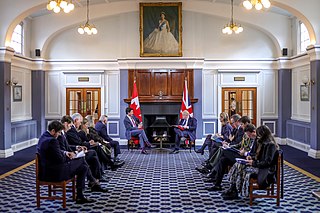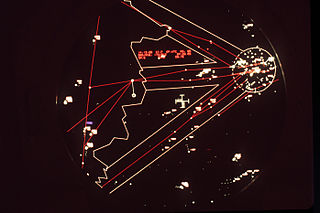
The Convair 990 Coronado was an American narrow-body four-engined jet airliner produced between 1961 and 1963 by the Convair division of American company General Dynamics. It was a stretched version of its earlier Convair 880 produced in response to a request from American Airlines: the 990 was lengthened by 10 ft (3.0 m), which increased the number of passengers from between 88 and 110 in the 880 to between 96 and 121. This was still fewer passengers than the contemporary Boeing 707 or Douglas DC-8, although the 990 was 25–35 mph (40–56 km/h) faster than either in cruise.
This is a list of aviation-related events from 1956.
This is a list of aviation-related events from 1960.
This is a list of aviation-related events from 1977.

Royal Air Force Northolt or more simply RAF Northolt is a Royal Air Force station in South Ruislip, 2 nautical miles from Uxbridge in the London Borough of Hillingdon, western Greater London, England, approximately 6 mi (10 km) north of Heathrow Airport. As London VIP Airport, the station handles many private civil flights in addition to Air Force flights.
Spantax S.A. was a Spanish leisure airline headquartered in Madrid that operated from 6 October 1959 to 29 March 1988. Spantax was one of the first Spanish airlines to operate tourist charter flights between European and North American cities and popular Spanish holiday destinations and was considered a major force in developing 20th-century mass tourism in Spain. Its popularity and image faded from the 1970s onward when a series of crashes and incidents revealed safety deficits, which, combined with rising fuel costs and increasing competition, resulted in the company facing severe financial difficulties that led to its demise in 1988.

The Convair C-131 Samaritan is an American twin-engined military transport produced from 1954 to 1956 by Convair. It is the military version of the Convair CV-240 family of airliners.

During the Cold War era (1945–1991), the West Berlin air corridors, also known as the Berlin corridors and control zone, were three regulated airways for civil and military air traffic of the Western Allies between West Berlin and West Germany passing over East Germany's territory. The corridors and control zone were physically centered on and under control of the all-Allied Berlin Air Safety Center (BASC) in West Berlin. The airspace within these corridors was used by US, UK and French-registered non-combat aircraft belonging to these countries' armed forces and airlines operated by pilots holding those countries' passports. In addition, it was also used by LOT Polish Airlines for regular scheduled services from Warsaw to London and Paris via Schönefeld Airport to the south of East Berlin.

In an internal combustion engine, fuel starvation is the failure of the fuel system to supply sufficient fuel to allow the engine to run properly, for example due to blockage, vapor lock, contamination by water, malfunction of the fuel pump or incorrect operation, leading to loss of power or engine stoppage. There is still fuel in the tank(s), but it is unable to get to the engine(s) in sufficient quantity. By contrast, fuel exhaustion is an occurrence in which the vehicle in question becomes completely devoid of usable fuel, with results similar to those of fuel starvation.

Munich-Riem Airport was the international airport of Munich, the capital city of Bavaria and third-largest city of Germany. It was closed down on 16 May 1992, the day before the new Munich Airport commenced operations. It was located near the old village of Riem in the borough of Trudering-Riem in the east of Munich.
Det Danske Luftfartselskab A/S or DDL, trading in English as Danish Air Lines, was Denmark's national airline from 1918 until it merged to create Scandinavian Airlines System (SAS) in 1951. DDL was established on 29 October 1918, but started its first scheduled route on 7 August 1920.

The 1948 Northwood mid-air collision took place on 4 July at 15:03 when a Douglas DC-6 of Scandinavian Airlines System (SAS) and an Avro York C.1 of the Royal Air Force (RAF) collided in mid-air over Northwood in London, UK. All thirty-nine people aboard both aircraft were killed. It was SAS's first fatal aviation accident and was at the time the deadliest civilian aviation accident in the UK. It is still the deadliest mid-air collision in British history.

Paninternational was a West German leisure airline headquartered in Munich with bases at Munich-Riem Airport and Düsseldorf Airport.

St. Paul's Church is a large Catholic church in the Ludwigsvorstadt-Isarvorstadt quarter of Munich, Bavaria, Germany. It was built in 1892–1906, designed by the Austrian architect Georg von Hauberrisser in the Gothic Revival style, north of the Theresienwiese.

Spantax Flight 275, registration number EC-BZR, was a Convair 990 Coronado charter flight operated by Spantax from Tenerife to Munich with 148 passengers and 7 crew. On December 3, 1972, the plane crashed while taking off from Tenerife-Norte Los Rodeos Airport in Tenerife, killing everyone aboard. Many of the passengers were West German tourists heading home.

On 10 July 2018, a Convair 340 owned by Dutch aviation museum Aviodrome crashed during a trial flight in Pretoria, South Africa. The aircraft suffered an engine fire moments after takeoff and crashed into a factory building as the crew attempted to return it to Wonderboom Airport.













